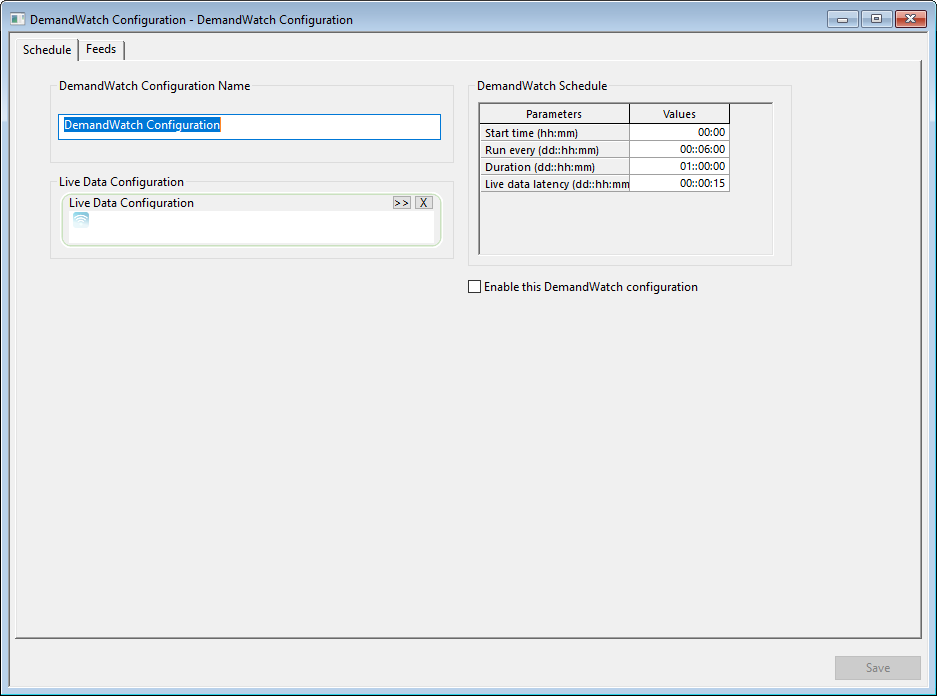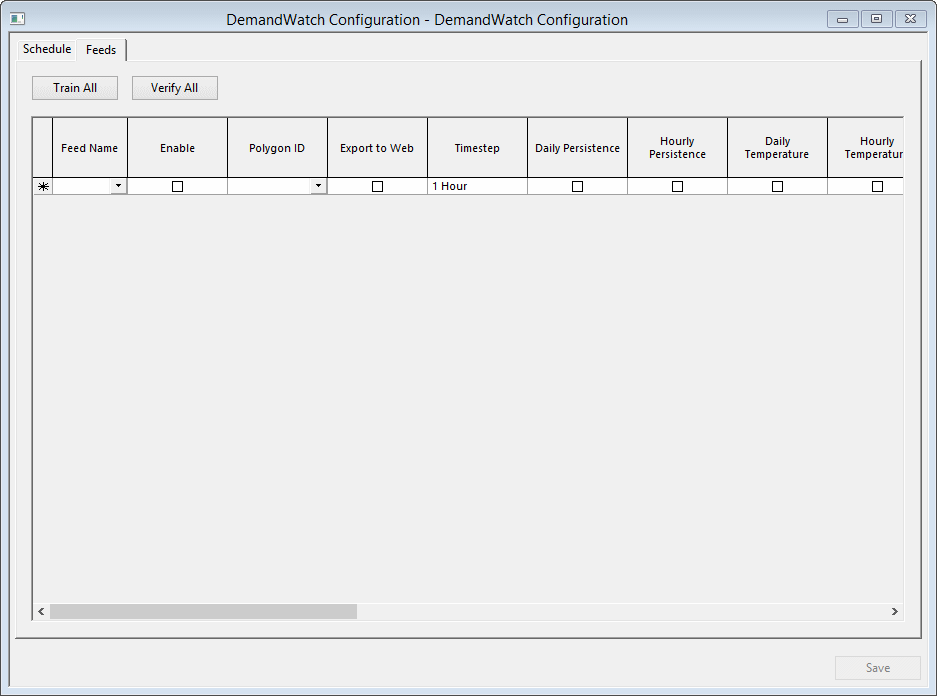The DemandWatch Configuration object is used to configure the schedule on the IWLive Pro server, to enable and disable the schedule on the server, and to train, verify, and edit DemandWatch model parameters for each individual data feed.
Schedule Page
The Schedule page is used to:
- specify a name for the DemandWatch Configuration object
- associate a Live Data object
- set a forecasting schedule

The table below lists the options available on this tab:
|
Option |
Description |
||||||||
|---|---|---|---|---|---|---|---|---|---|
|
DemandWatch Configuration Name |
The name of the DemandWatch configuration object is used throughout the system, for all users. It can be changed at any time. The software will enforce uniqueness. A new name will be visible to all users. |
||||||||
|
Live Data Configuration |
Select a Live Data Configuration item containing links to the telemetry and temperature data to be used. All the live feeds for the associated live data configuration object will automatically be added to the list of feeds in the Feeds tab Note: If more than one live data object is dropped into this droptarget, only the first one will be taken into account.
|
||||||||
|
DemandWatch Schedule |
The DemandWatch Schedule parameters are used to schedule timing for forecasts.
|
||||||||
|
Enable this DemandWatch configuration |
Check the Enable this DemandWatch configuration option to enable forecast runs to be carried out on the IWLive Pro server. This option will be enabled only when the DemandWatch Configuration is checked in. Tip: It is also possible to enable a DemandWatch configuration object by right-clicking it in the Explorer or Model Window and selecting
Enable DemandWatch Configuration from the context menu.
|
||||||||
| Export to Web | ~ |
Feeds Page
The Feeds Page is used to specify and configure the feeds to run on the IWLive Pro server. Using this tab, users can also:
- Train and verify feeds in bulk or individually
- view and edit feed properties
- Access model parameters

The table below contains the options available on this tab:
|
Train All |
Click this button to train all enabled feeds. Tip: Feeds can be individually trained by using the
Train context menu option for the relevant row (see below for further details) or by using the
Train button present in the
Properties tab of the feed
Properties dialog.
|
|
Verify All |
Click this button to verify all enabled feeds. Tip: Feeds can be individually verified by using the
Verify context menu option for the relevant row (see below for further details) or by using the
Verify button present in the
Properties tab of the feed
Properties dialog.
|
|
Feed Name |
Name of the feed. This drop-down list contains all the available feeds, as specified in the Live Data Feed page of the Live Data object. Select a feed. Tip: Each feed can only be used once in a DemandWatch Configuration object.
|
|
Enable |
Check this option to enable the feed so it is used in forecast runs by the IWLive Pro server. |
|
Timestep |
Demand forecast timestep. Available values are 5 mins, 10 mins, 15 mins, 20 mins, 30 mins, 1 hour and 2 hours. Note: If the demand forecast timestep is modified for an existing model, it is necessary to re-train that model.
|
|
Daily Persistence |
Enable this option to use the 24 hour short term memory component during training and forecast (PSI24). |
|
Hourly Persistence |
Enable this option to use the 1 hour short term memory component during training and forecast (PSI1). |
|
Daily Temperature |
Valid for temperature feeds only. Enable this option to use the temperature feed specified in the Temperature Feed field during training and forecast to adjust the daily demand forecast values. |
|
Hourly Temperature |
Valid for temperature feeds only. Enable this option to use the temperature feed specified in the Temperature Feed field during training and forecast to adjust the hourly demand forecast values. Tip: Although the hourly demand values are adjusted by the temperature, only 1 temperature value per day is required.
|
|
Temperature Feed |
This dropdown list contains all the available temperature feeds. Note: Only feeds with an external unit of
DegC or
DegF (See Live Data Feed view) will appear in the list.
Select a temperature feed from the list. The temperature feed specified here will be used during training and forecast. |
|
Train From |
Training period. This period should be at least 12 months span. |
|
Train To |
|
|
Training Goodness of fit (R2) |
Read only (calculated) field. Variance explained by the training (max is 1). |
|
Training RMSE |
Read only (calculated) field. Training Root Mean Square Error or accuracy. This parameter measures the difference between training values and the raw values actually measured. The smaller this value the more accurate the training. |
|
Verify From |
Verification period. This period should be at least of 1 month. |
|
Verify To |
|
|
Verification Goodness of fit (R2) |
Read only (calculated) field. Variance explained by the verification (max is 1). |
|
Verification RMSE |
Read only (calculated) field. Verification Root Mean Square Error or accuracy. This parameter measures the difference between values predicted by the model and the raw values actually measured. The smaller this value the more accurate the verification. |
|
Export Feed Name |
Name of the export feed. This drop-down list contains all the available export feeds, as specified in the Live Data Export page of the Live Data object. Select a feed. |
| Filter Change Threshold |
Threshold defining a change in flow values. If the change in the incoming data during the Filter Minimum Duration is less than the threshold, the incoming data is discarded (value difference is considered to be negligible). In other words, if the data flat-lines the incoming data is discarded as long as the change in the data during the flat-lining is less than the filter change threshold. |
|
Filter Minimum Duration |
Minimum duration after which a data feed value that is not considered to have changed compared to the initial value (see Filter Change Threshold above) will be discarded. |
|
Filter Max |
Maximum flow value allowed. Data values equal to or larger than the filter max will be discarded. |
|
Filter Min |
Minimum flow value allowed. Data values equal to or less than the filter min will be discarded. |
| Leakage Detection Enable | Enable the leakage detection for this field. |
| Leakage Detection Timestep | Timestep for the leakage detection. |
| Alpha | Detection threshold: if a value is outside Alpha standard deviations then it is detected as an event. |
| Event Threshold | Number of abnormal increase events required before a leakage event is detected. |
| Leakage Detection Variable | One of the following: Minimum night; Average day. |
| Sample Size | Number of samples used to calculate the initial average and standard deviation. |
| Sample Start Date | Samples are taken from this date to calculate the initial average and standard deviation. It is advisable to choose a period where there are no abnormal leaks. |
| Leakage Detection Export Feed | Feed to export the leakage events. |
Context menu options
Available context menu options are detailed below:
Delete Row - Only available for Feed Name. Delete the selected row.
Train - Train the selected feed.
Verify - Verify the selected feed.
Properties - Opens the Properties dialog for the selected feed. The Properties dialog allows the user to view and edit individual feeds / model parameters for individual feeds. Using this dialog, it is also possible to run a forecast over a user-defined period, to graphically view results and export them to CSV.
Additionally values can be sorted in ascending or descending order.